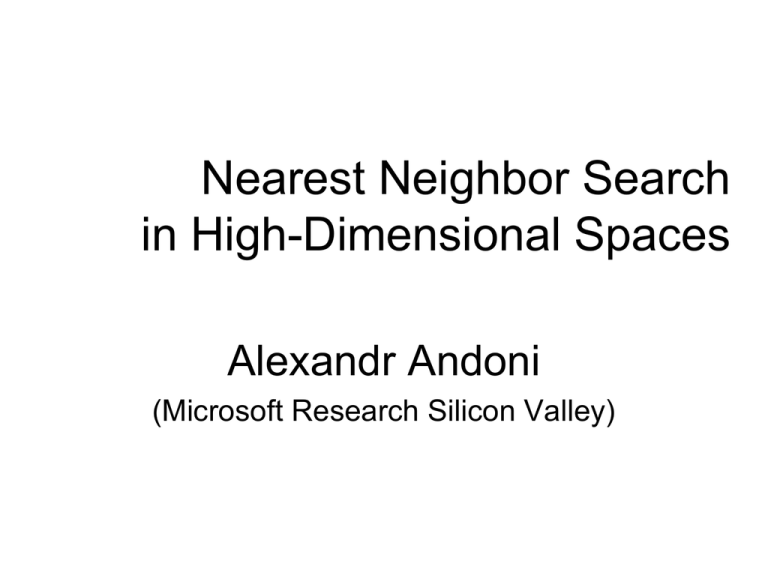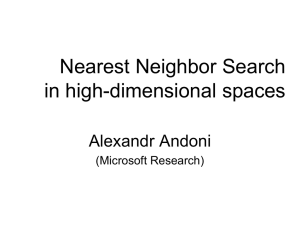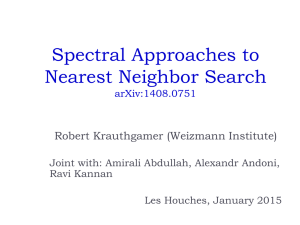Nearest Neighbor Search in High-Dimensional Spaces
advertisement

Nearest Neighbor Search
in High-Dimensional Spaces
Alexandr Andoni
(Microsoft Research Silicon Valley)
Nearest Neighbor Search (NNS)
Preprocess: a set D of
points
Query: given a new point q,
report a point pD with the
smallest distance to q
p
q
Motivation
Generic setup:
000000
011100
010100
000100
010100
011111
Points model objects (e.g. images)
Distance models (dis)similarity measure
Application areas:
000000
001100
000100
000100
110100
111111
machine learning: k-NN rule
data mining, speech recognition, image/
video/music clustering, bioinformatics, etc…
Distance can be:
Euclidean, Hamming, ℓ∞,
edit distance, Ulam, Earth-mover distance, etc…
Primitive for other problems:
find the closest pair in a set D, MST, clustering…
p
q
Further motivation?
eHarmony: 29 Dimensions® of Compatibily
4
Plan for today
1. NNS for basic distances
2. NNS for advanced distances: reductions
3. NNS via composition
Plan for today
1. NNS for basic distances
2. NNS for advanced distances: reductions
3. NNS via composition
Euclidean distance
7
2D case
Compute Voronoi diagram
Given query q, perform
point location
Performance:
Space: O(n)
Query time: O(log n)
High-dimensional case
All exact algorithms degrade rapidly with the
dimension d
Algorithm
Query time
Space
Full indexing
O(d*log n)
nO(d) (Voronoi diagram size)
No indexing –
linear scan
O(dn)
O(dn)
In practice:
When d is “medium”, kd-trees work better
When d is “high”, state-of-the-art is unsatisfactory
Approximate NNS
r-near neighbor: given a new
point q, report a point pD s.t.
||p-q||≤rcr
as long as there exists
a point at distance ≤r
Randomized: a near neighbor
returned with 90% probability
r
cr
q
p
Alternative view: approximate NNS
r-near neighbor: given a new
point q, report a set L with
all points point pD s.t. ||p-q||≤r
(each with 90% probability)
may contain some approximate
neighbors pD s.t. ||p-q||≤cr
Can use as a heuristic for
exact NNS
r
cr
q
p
Approximation Algorithms for NNS
A vast literature:
with exp(d) space or Ω(n) time:
[Arya-Mount’93], [Clarkson’94], [Arya-MountNetanyahu-Silverman-We’98], [Kleinberg’97], [HarPeled’02],…
with poly(n) space and o(n) time:
[Indyk-Motwani’98], [Kushilevitz-Ostrovsky-Rabani’98],
[Indyk’98, ‘01], [Gionis-Indyk-Motwani’99],
[Charikar’02], [Datar-Immorlica-Indyk-Mirrokni’04],
[Chakrabarti-Regev’04], [Panigrahy’06], [AilonChazelle’06], [A-Indyk’06]…
The landscape: algorithms
Space
Time
Comment
Reference
Space: poly(n).
n4/ε2+nd O(d*log n) c=1+ε
Query: logarithmic
[KOR’98, IM’98]
Space: small poly n1+ρ +nd dnρ
(close to linear).
Query: poly
(sublinear).
ρ≈1/c
[IM’98, Cha’02, DIIM’04]
Space: near-linear. nd*logn dnρ
Query: poly
(sublinear).
ρ=2.09/c
[Ind’01, Pan’06]
ρ=O(1/c2)
[AI’06]
ρ=1/c2 +o(1) [AI’06]
Locality-Sensitive Hashing
[Indyk-Motwani’98]
q
Random hash function g:
RdZ s.t. for any points p,q:
p
q
For a close pair p,q: ||p-q||≤r,
P1= Pr[g(p)=g(q)] is “high”
“not-so-small”
P2=For a far pair p,q: ||p-q||>cr,
Pr[g(p)=g(q)] is “small”
Use several hash
tables: nρ, where ρ<1 s.t.
Pr[g(p)=g(q)]
1
P1
P2
||p-q||
r
cr
Example of hash functions: grids
[Datar-Immorlica-Indyk-Mirrokni’04]
Pick a regular grid:
Shift and rotate randomly
Hash function:
g(p) = index of the cell of p
Gives ρ ≈ 1/c
p
Near-Optimal LSH
[A-Indyk’06]
Regular grid → grid of balls
p
p can hit empty space, so take
more such grids until p is in a ball
Need (too) many grids of balls
Start by projecting in dimension t
Analysis gives
Choice of reduced dimension t?
2D
Tradeoff between
# hash tables, n, and
Time to hash, tO(t)
Total query time: dn1/c2+o(1)
p
Rt
p
Proof idea
Claim:
, i.e.,
P(r)=probability of collision when ||p-q||=r
Intuitive proof:
Projection approx preserves distances [JL]
P(r) = intersection / union
P(r)≈random point u beyond the dashed line
Fact (high dimensions): the x-coordinate of u
has a nearly Gaussian distribution
→ P(r) exp(-A·r2)
𝑃 𝑟 = exp −𝐴𝑟 2 = exp(−𝐴(𝑐𝑟)2
1/𝑐 2
1/𝑐 2
= 𝑃(𝑐𝑟)
qq
r
p
P(r)
x
u
Challenge #1:
More practical variant of above hashing?
Design space partitioning of Rt that is
efficient: point location in poly(t) time
qualitative: regions are “sphere-like”
2
c
[Prob. needle of length 1 is not cut]
≥
[Prob needle of length c is not cut]
The landscape: lower bounds
Space
Time
Comment
Space: poly(n).
n4/ε2+nd O(d*log n) c=1+ε
Query: logarithmic o(1/ε2)
n
ω(1) memory lookups
Space: small poly 1+ρ
n +nd dnρ
(close to linear).
Query: poly
(sublinear).
n1+o(1/c2)
ρ≈1/c
[KOR’98, IM’98]
[AIP’06]
[IM’98, Cha’02, DIIM’04]
ρ=1/c2 +o(1) [AI’06]
ρ≥1/c2
ω(1) memory lookups
Space: near-linear. nd*logn dnρ
Query: poly
(sublinear).
Reference
[MNP’06, OWZ’10]
[PTW’08, PTW’10]
ρ=2.09/c
[Ind’01, Pan’06]
ρ=O(1/c2)
[AI’06]
Other norms
Euclidean norm (ℓ2)
Locality sensitive hashing
Hamming space (ℓ1)
also LSH
(in fact in original [IM98])
Max norm (ℓ)
Don’t know of any LSH
next…
ℓ=real space with distance:
||x-y||=maxi |xi-yi|
20
NNS for ℓ∞ distance
ℓ=real space with distance:
||x-y||=maxi |xi-yi|
[Indyk’98]
Thm: for ρ>0, NNS for ℓ∞d with
O(d * log n) query time
n1+ρ space
O(lg1+ρ lg d) approximation
The approach:
A deterministic decision tree
Similar to kd-trees
Challenge
Each
node #2:
of DT is “qi < t”
q1<5 ?
Yes
One difference: algorithms goes
q2<4 ?
O(1) space,
down the
treeapproximation
once
Obtain
O(1)
with nYes
No
(while
tracking
the
list
of
possible
and
sublinear query time NNS under ℓ∞ .
neighbors)
q1<3 ?
[ACP’08]: optimal for
deterministic decision trees!
No
q2<3 ?
Plan for today
1. NNS for basic distances
2. NNS for advanced distances: reductions
3. NNS via composition
What do we have?
Classical ℓp distances:
Euclidean (ℓ2), Hamming (ℓ1), ℓ∞
How about other distances?
E.g.:
Edit (Levenshtein) distance: ed(x,y) = minimum
number of insertions/deletions/substitutions
operations that transform x into y.
Very similar to Hamming distance…
or Earth-Mover Distance…
Earth-Mover Distance
Definition:
Given two sets A, B of points in a metric space
EMD(A,B) = min cost bipartite matching between A
and B
Which metric space?
Can be plane, ℓ2, ℓ1…
Applications in image vision
Embeddings: as a reduction
For each XM, associate a vector
f(X), such that for all X,YM
||f(X) - f(Y)|| approximates original
distance between X and Y
Has distortion A ≥ 1 if
dM(X,Y) ≤ ||f(X)-f(Y)|| ≤ A*dM(X,Y)
Reduce NNS under M to NNS for
Euclidean space!
f
Can also consider other “easy”
distances between f(X), f(Y)
Most popular host: ℓ1≡Hamming
f
Earth-Mover Distance over 2D into ℓ1
[Charikar’02, Indyk-Thaper’03]
Sets of size s in [1…s]x[1…s] box
Embedding of set A:
impose randomly-shifted
grid
Each grid cell gives
a coordinate:
f (A)c=#points in the cell c
Subpartition the grid
recursively, and assign
new coordinates for each
new cell (on all levels)
00
02
00
11
12
01
01
22
20
00
Distortion: O(log s)
26
Embeddings of various metrics
Embeddings into Hamming space (ℓ1)
Metric
Upper bound
Edit distance over {0,1}d
Ulam (edit distance
between
Challenge
3:
permutations)
O(log d)
Block edit distance
Õ(log d)
[CK06]
Improve the distortion
of embedding
[MS00, CM07]
distance, EMD
ℓ1
Earth-moveredit
distance
O(log into
s)
(s-sized sets in 2D plane)
Earth-mover distance
(s-sized sets in {0,1}d)
[Cha02, IT03]
O(log s*log d)
[AIK08]
Are we done?
“just” remains to find an embedding
with low distortion…
No, unfortunately
A barrier: ℓ1 non-embeddability
Embeddings into ℓ1
Metric
Upper bound
Lower bound
Ω(log d)
Edit distance over {0,1}d
[KN05,KR06]
Ulam (edit distance between
permutations)
O(log d)
Block edit distance
Õ(log d)
Ω̃(log d)
[AK07]
[CK06]
4/3
[MS00, CM07]
Earth-mover distance
(s-sized sets in 2D plane)
O(log s)
Earth-mover distance
(s-sized sets in {0,1}d)
O(log s*log d)
[Cor03]
[Cha02, IT03]
[AIK08]
Ω(log s)
[KN05]
Other good host spaces?
What is “good”:
ℓ2, ℓ1 sq-ℓ2, etc ℓ∞
is algorithmically tractable
is rich (can embed into it)
sq-ℓ2=real space with distance: ||x-y||22
Metric
Edit distance over {0,1}d
Ulam (edit distance
sq-ℓ2, hosts with very good
Lower bound into ℓ1 LSH (lower bounds via
̃
Ω(log
d)
communication complexity)
[AK’07]
[AK07]
[AK’07]
[KN05]
[AIK’08]
Ω̃(log d)
between permutations)
Earth-mover distance
(s-sized sets in {0,1}d)
[KN05,KR06]
Ω(log s)
Plan for today
1. NNS for basic distances
2. NNS for advanced distances: reductions
3. NNS via composition
α
Meet our new host
[A-Indyk-Krauthgamer’09]
…
…
…
Iterated product space
𝛾
sq−ℓ2
𝛽
ℓ∞
d1
d1
d1
𝛼
ℓ1
β
d∞,1
d∞,1
d∞,1
d22,∞,1
γ
𝑥 = 𝑥1 , … , 𝑥𝛼 ∈ 𝑅𝛼
𝛼
𝑑1 𝑥, 𝑦 =
|𝑥𝑖 − 𝑦𝑖 |
𝑖=1
𝛼
𝛼
𝛼
𝑥 = 𝑥1 , … , 𝑥𝛽 ∈ ℓ1 × ℓ1 × ⋯ ℓ1
𝑑∞,1 𝑥, 𝑦 = 𝑚𝑎𝑥𝑖=1..𝛽 𝑑1 (𝑥𝑖 , 𝑦𝑖 )
𝛽
𝛼
𝛽
𝛼
𝑥 = 𝑥1 , … , 𝑥𝛾 ∈ ℓ∞ ℓ1 × ⋯ × ℓ∞ ℓ1
𝑑22,∞,1 𝑥, 𝑦 =
𝛾
𝑖=1
𝑑∞,1 (𝑥𝑖 , 𝑦𝑖 )
2
32
Why
𝛾
sq−ℓ2
𝛽
ℓ∞
ℓ1𝛼
[A-Indyk-Krauthgamer’09, Indyk’02]
Because we can…
?
edit distance between permutations
ED(1234567,
7123456) = 2
𝛾
𝛽
𝛼
Algorithmically
Rich
tractable
Embedding: …embed Ulam into sq−ℓ2 ℓ∞ ℓ1
with constant distortion
dimensions = length of the string
NNS: Any t-iterated product space has NNS on
n points with
(lg lg n)O(t) approximation
near-linear space and sublinear time
Corollary: NNS for Ulam with O(lg lg n)2 approx.
Better than each ℓp component separately!
(each ℓp part has a logarithmic lower bound)
Embedding into
𝛾
sq−ℓ2
𝛽
ℓ∞
𝛼
ℓ1
Theorem: Can embed Ulam metric over
𝛾 𝛽 𝛼
d
[d] into sq−ℓ2 ℓ∞ ℓ1 with constant
distortion
Dimensions: α=β=γ=d
Proof intuition
Characterize Ulam distance “nicely”:
“Ulam distance between x and y equals the number
of characters that satisfy a simple property”
“Geometrize” this characterization
Ulam: a characterization
[Ailon-Chazelle-Commandur-Lu’04, Gopalan-JayramKrauthgamer-Kumar’07, A-Indyk-Krauthgamer’09]
Lemma: Ulam(x,y) approximately
equals the number of “faulty”
characters a satisfying:
there exists K≥1 (prefix-length) s.t.
the set of K characters preceding a in x
differs much from
the set of K characters preceding a in y
E.g., a=5; K=4
X[5;4]
x= 123456789
y= 123467895
Y[5;4]
Ulam: the embedding
X[5;4]
“Geometrizing” characterization:
123467895
123456789
Y[5;4]
Gives an embedding
𝑓 𝑋 =
1
𝟏𝑋[𝑎;𝐾]
2𝐾
𝛾
𝐾=1…𝑑
𝛽
𝛼
∈ sq−ℓ2 ℓ∞ ℓ1
𝑎=1…𝑑
Distance as low-complexity computation
Gives more computational view of embeddings
Ulam characterization is related to work in the
context of sublinear (local) algorithms:
property testing & streaming [EKKRV98, ACCL04,
GJKK07, GG07, EJ08]
𝛾
sq−ℓ2
𝛽
ℓ∞
𝛼
ℓ1
=
sum of squares (sq-ℓ2) edit(P,Q)
max (ℓ∞)
sum (ℓ1)
X
Y
Challenges 4,…
Embedding into product spaces?
Of edit distance, EMD…
NNS for any norm (Banach space) ?
Would help for EMD (a norm in fact!)
A first target: Schatten norms (e.g., trace of a
matrix)
Other uses of embeddings into product
spaces?
Related work: sketching of product spaces, used in
streaming applications [JW’09, AIK’08, AKO’11]
Some aspects I didn’t mention yet
NNS with black-box distance function, assuming a low
intrinsic dimension:
[Clarkson’99], [Karger-Ruhl’02], [Hildrum-Kubiatowicz-MaRao’04], [Krauthgamer-Lee’04,’05], [Indyk-Naor’07],…
Lower bounds for deterministic and/or exact NNS:
[Borodin-Ostrovsky-Rabani’99], [Barkol-Rabani’00], [JayramKhot-Kumar-Rabani’03], [Liu’04], [Chakrabarti-Chazelle-GumLvov’04], [Pătraşcu-Thorup’06],…
NNS with random input:
[Alt-Heinrich-Litan’01], [Dubiner’08],…
Solving other problems via reductions from NNS:
[Eppstein’92], [Indyk’00],…
Many others !
Some highlights of approximate NNS
Iterated product spaces
Locality-Sensitive Hashing
Decision trees
Euclidean space ℓ2
Hamming space ℓ1
Max norm ℓ
logarithmic (or more) distortion
Hausdorff distance
Edit distance
Earth-Mover Distance
constant distortion
Ulam distance
40
Some challenges
1. Design qualitative, efficient
space partitioning in Euclidean space
2. O(1) approximation NNS for ℓ
3. Embeddings with improved distortion of
edit distance, Earth-Mover Distance:
into ℓ1
into product spaces
𝛾
sq−ℓ2
𝛽
ℓ∞
𝛼
ℓ1
4. NNS for any norm: e.g. trace norm?







